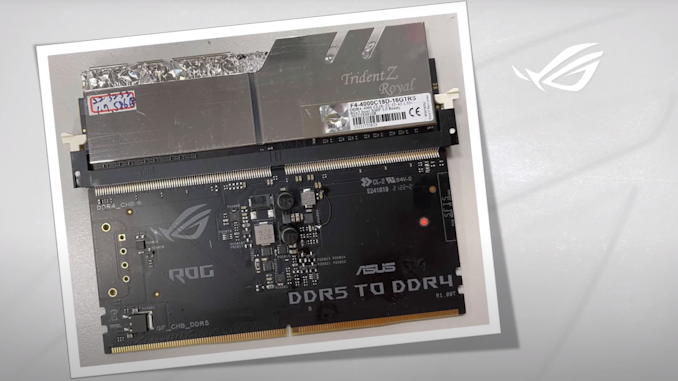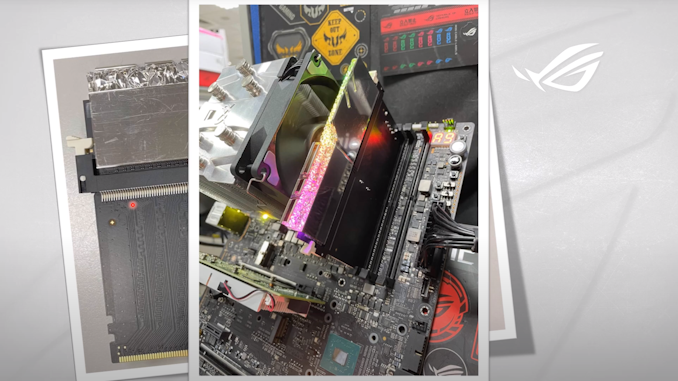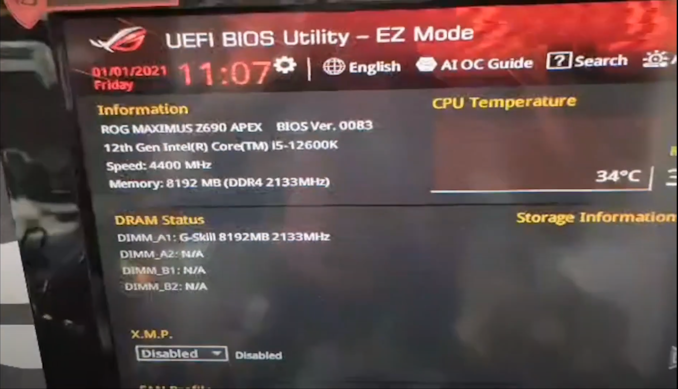ASUS Demonstrates DDR5 to DDR4 Converter Card
by Dr. Ian Cutress on December 30, 2021 2:01 PM EST
One of the key issues with purchasing a modern Alder Lake system today is the cost of the memory, especially when an enthusiast wants to use DDR5. Due to component shortages, particularly the power management controllers that each DDR5 module needs, costs of DDR5 are quickly rising, with some scalpers looking for $1000+ for basic memory kits. The solution to this has been to recommend that users look to pair Alder Lake with DDR4 memory, which although it isn’t the latest, is the more cost effective scenario. The downside to this solution is that the user has a DDR4-only motherboard, and not the next generation DDR5. That might become a solved issue soon enough, however.
In a preview video on YouTube posted today by Bing, who I believe is an ASUS ROG employee, the company has been working on a solution to allow users that buy ASUS Z690 motherboards built on DDR5, to run DDR4 in them. Because Intel limited the platform to either DDR5 or DDR4 per motherboard, there’s no way to run both, until now. In the video, Bing describes the new add-in card they’ve been prototyping.
The use case is fairly simple – have a DDR5 board like the ROG Apex, put the carrier card in a memory slot, and place the qualified DDR4 in the top.
Obviously, the situation here is more complex than simply using this carrier card. DDR5 and DDR4 are more than simply a notch difference between them – DDR4 is a single 64-bit memory channel per module, while DDR5 is dual 32-bit channel per module. The key issue is that DDR5 does power management per module, where DDR4 relies on power management on the motherboard, so that has to be taken into consideration. Also, adding in a carrier card extends memory traces, which could degrade the quality of the signal.
What ASUS does here is use a special BIOS revision to allow the ROG Apex DDR5 to run in DDR4 mode. This means that the traces to the memory slots, although laid out for DDR5 operation, are switched into DDR4 mode. Then, on the carrier card, this takes the 5V power signal and runs it through the equivalent of motherboard power management, and controls the data lines to maintain integrity for signal, latency, power, etc.
Bing explains in the video that this is still very much a prototype. It looks like they’re focusing to get it to work on one motherboard with one memory kit first, before optimizing it. Bing states that the carrier card is very tall, and there is room for optimization to make it smaller in the future before ASUS might offer it as a retail product. Also a wider range of validation is likely needed as well.
The video goes to show with a single DDR4 module in the carrier card the system running at DDR4-4400 with a Core i5-12600K. To confirm DDR5 still works, the system is shown running dual modules of DDR5-4400, at least to the BIOS screen. If these modules come to market, they are still in early prototypes, and ASUS will likely judge feasibility and demand for them for pricing.
Source: YouTube (in Mandarin)













31 Comments
View All Comments
web2dot0 - Friday, December 31, 2021 - link
But Apple computers aren't upgradeable .... hahahaha.This is precisely why people don't upgrade their computers. Instead, people just buy new ones.
There's no point ... technology change so fast that in 3-5years after your computer purchase, you mind as well sell your laptop/desktop and buy a brand new one.
Trying to upgrade RAM/SSD/CPU/GPU is a fools errand.
DDR4 --> DDR5
PCI3 --> PCI4/5
CPU Socket changes
USB3 --> USB4/TB4
Hell, even WIFI6 --> WIFI6E
Yearly computer upgrades are for nerds and geeks.
Regular people upgrade their computers in 3-5-7-10years intervals.
Oxford Guy - Friday, December 31, 2021 - link
‘This is precisely why people don't upgrade their computers’There have been situations that make upgrading worthwhile, such as a family member’s system that has 16 GB of 3200, a B450 Tomahawk, and a Zen 1 CPU.
Upgrading that system to a Zen 3 chip is a no-brainer, especially since he lives near a MicroCenter.
Apple machines also used to frequently benefit tremendously from things like replacing mobile hard drives with SSDs and increasing the RAM.
DigitalFreak - Friday, December 31, 2021 - link
Always makes me laugh when people scream about Intel changing their socket ever couple of years. So what? If you upgrade your CPU every year you are an idiot.ayunatsume - Saturday, January 1, 2022 - link
That't not the only reason.Ever had a PC that you bought mid-range because of cost that lasted you, what, 4-8 years? Then you figure that the newest entry-level or mid-range processor is basically as fast as the fastest one available for your socket/platform? You always have the option of just buying a cheap old stock or used processor to upgrade your "old" PC to its best potential at probably the same or lower cost that the processor ALONE of you new build.
Save for instance, my old but trusty 2500k. At 4.4GHz, it's still as fast as a i5-6500 or a Ryzen 1400-1600. Give it a 2600k/3770k and push the memory to 1866MHz-2133MHz and you just bumped your PC up to catch up a bit more. Maybe just enough to hold on to AM5/DDR5 when you can finally make that complete generational leap into another "upgradable" socket.
That's what I did -- my PC can still do some video editing, heavy photoshop, and 1440p60 gaming.
Same for the people who have AM4 systems right now -- they don't need to surrender to scalping on DDR5 and whatnot, they can just push their B450 boards from a Ryzen 1400 to a 5800x when the need arises -- especially useful when the pricing of latest tech right now is just utter bull and insane.
I've even had some life breathed into my old G43/P45 LGA775 systems -- they started life out with a Pentium 4 945, a Pentium Dual Core E2100, or a Core 2 Duo E4400 -- now they all got Core 2 Quads I got for 10 bucks each. My AM3+ systems that started with an Athlon 2 x2? Well they got FX-6300s or a Phenom 965/1055 now. All of them still perfect for still image and office tasks. Heck the FX-6300 is even doing AI :)
bill.rookard - Sunday, January 2, 2022 - link
Exactly. I picked up a Ryzen 1700 quite some time ago. Should I ever decide to upgrade my system, I can pick up a used 3000 series Zen chip, or go as you mentioned right up to 5000 series Zen which is current generation, and the compute capability will go up quite a bit. You know what though, my 1700 still crunches numbers pretty damn well. Coupled with a Titan Black (yeah - that's pretty old) it's a pretty decent machine.damianrobertjones - Sunday, January 2, 2022 - link
Sits here, typing, on a 12th gen computer that he built himself. Looks across to the 10th gen rig, that could have had an 11th gen cpu added.Regrets nothing.
back2future - Sunday, January 2, 2022 - link
depends on preferences: upcycling stable hardware with new cpu (AMD on 10-15yrs period?) or adding new peripherals with upgrading a mainboard (Intel on a maybe 5yrs period?) at higher overall cost for newer standards.What do we compare, if for e.g. DDR4 is still accepted standard, where cpus on sockets are upgraded, instead of changing a whole system (cpus, mainboard, disks, memory, ). It's easy changing hdd with sdd on s-ata or pcie, because connectors and protocols have been kept stable and compatible. Changing power supply for memory, or going from 4.6GHz to 7.2GHz data transfer clock speed raises cost and demand on quality for materials, also.
It is a decision between different systems of upgrading "philosophy" between AMD and Intel?
mode_13h - Sunday, January 2, 2022 - link
Depends on your needs. If you do something where the added speed of Alder Lake provides a noticeable benefit, then it might've been worthwhile.I wouldn't typically recommend anyone do a single-generation upgrade, unless you're also starting with a low/mid-tier CPU and just looking for the most cost-effective way to add some horsepower.
mode_13h - Sunday, January 2, 2022 - link
> This is precisely why people don't upgrade their computers. Instead, people just buy new ones.I typically do a mid-life upgrade of my PC memory by doubling it. On the PC I'm using right now, I've actually done 2 such upgrades.
> technology change so fast that in 3-5years after your computer purchase,
> you mind as well sell your laptop/desktop and buy a brand new one.
I've never replaced a PC after less than 7 years or so. I buy towards the upper-end of the range do a mid-life upgrade of the memory & storage (sometimes also the GPU) and that's always worked fine for me.
> CPU Socket changes
I never upgraded a CPU, in a personal machine (aside from an old laptop!). However, that's because I always start towards the upper end. If someone buys a mid-range CPU and replaces it with an upper-end CPU from a newer generation, it can indeed be a very worthwhile upgrade. True, even with AM4 boards, you're somewhat limited in terms of how many generations they can span, and you don't necessarily get all the benefits the newer CPU can provide.
> Yearly computer upgrades are for gamers.
Fixed that for you.
MommiesBoobas - Friday, February 11, 2022 - link
You're missing the point! This module is so you can buy a next gen motherboard and use your old RAM until you can find or obtain the DDR5 RAM.... You're not really losing anything because this allows you to be able to buy a Superior component and still be able to use it without having to waste your money buy settling on buying an older gen or inferior product that will become obsolete!